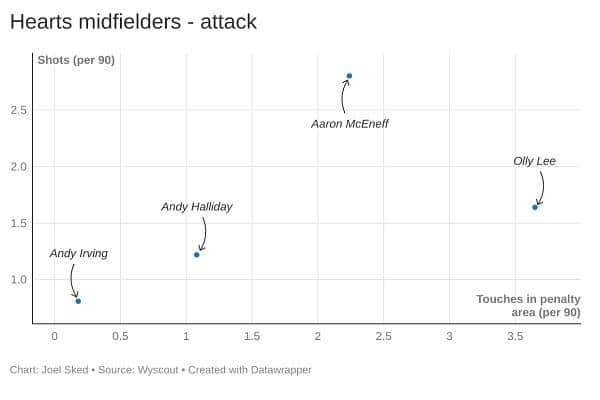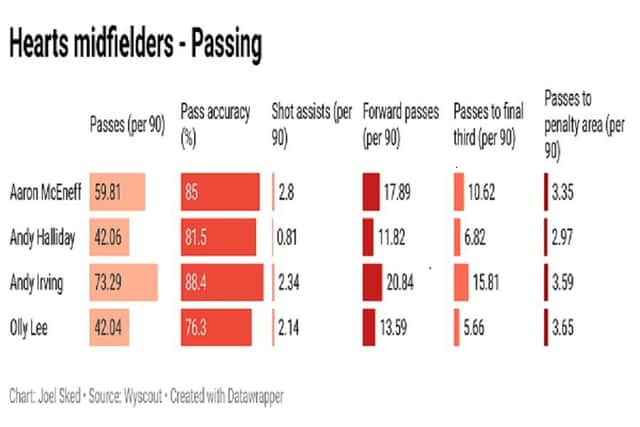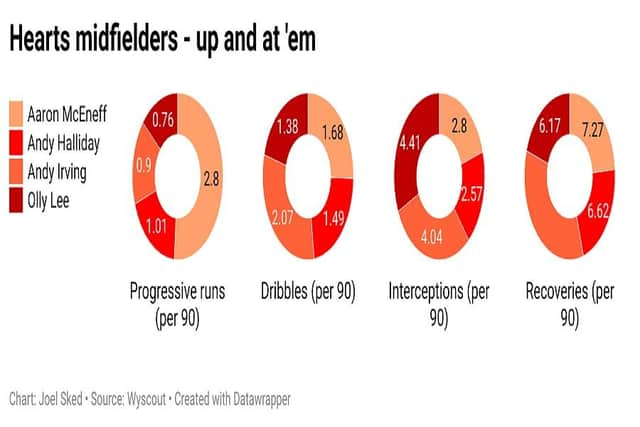Hearts: Aaron McEneff's positive numbers and how they compare to midfield team-mates


Olly Lee’s departure and Aaron McEneff’s arrival changed the dynamic somewhat during the January transfer window.
Andy Halliday and Andy Irving have largely been the favoured pairing, starting nine of the last 12 league games together.
Advertisement
Hide AdAdvertisement
Hide AdAs for Peter Haring, he hasn’t been seen since being replaced at half-time of the 3-1 loss to Dundee.
McEneff had a positive impact on the team in his first start against Greenock Morton last weekend after two sub appearances in away games at Ayr United and Queen of the South.
He displayed that all-action, box-to-box quality with an early chance and the awareness to win the ball back and put pressure on opponents. It suggested that he was ready to fill a gap which had been missing since Lee, who had a significant impact in the final third.
With the player still adapting to Scottish football following his move there will certainly be more to come.
Advertisement
Hide AdAdvertisement
Hide AdCrunching the Championship numbers of McEneff, Halliday, Irving and Lee via Wyscout, it throws up some interesting findings.


Attack
Neither Irving or Halliday are hugely influential in the box or when it comes to being a goal threat.
The latter has netted a couple of goals and spoke earlier this month about wanting to add more to his game.
He said: “I scored two pretty early on in the season — and I can’t hit a barn door ever since! I’ve missed quite a few chances.


Advertisement
Hide AdAdvertisement
Hide Ad“I’m constantly pushing myself to get better and, although people tell me it’s positive that I’m getting in the right positions, I don’t see it as a positive if I’m missing the chances.”
The player perhaps needs to look to shoot more than the 1.22 shots per 90 he is currently averaging. In advanced positions he has that quality, as shown against Dundee and Alloa, but has not been aided by not being played in after making dangerous runs.
Contrast that with McEneff who is posting some very encouraging numbers with regards to what Robbie Neilson wants from at least one of his midfielders.
As we can see from the graph, the Irishman is getting plenty of shots off per 90 minutes (2.8) compared to his team-mates and is looking to get into the box as well, albeit his 2.24 touches in the penalty area per 90 is not quite at Lee’s impressive 3.65 before his move to Gillingham.


Advertisement
Hide AdAdvertisement
Hide AdHe may not have been the most dynamic of players but had the vision and awareness with regards to what runs to make in and around the box.
That is something the 25-year-old will be tasked with and has talked about his third-man runs which are so difficult for opponents to defend against.
"Them types of runs forward, third-man runs off the back of people, drifting into the box, sometimes coming in and starting the play, playing forward.” he said.
Passing and build-up play
Irving was dropped for the weekend’s game against Morton. It could be argued he hadn’t reached the standards that many expect in previous games but you can see how decisive he is to the build-up play.
Advertisement
Hide AdAdvertisement
Hide AdWith 73.29 passes per 90 – plus an accuracy of 88.4 per cent – he is constantly involved, looking to get on the ball and direct the team. He averages 14 more passes than his nearest team-mate which is McEneff.
His ability to take the ball on the half-turn, start play from deep and entice and evade opponents can be key in opening up the game.
Irving is far from someone who plays safe or takes the easy way out. It is important to note the nature of his passes.
More than a quarter of his passes per 90 are getting the ball forward with the majority of those into the final third. Only McEneff comes close on both accounts.
Advertisement
Hide AdAdvertisement
Hide AdDespite often playing as the deepest of midfielders, it is even more impressive that only Lee has averaged more passes into the penalty area.
We also see McEneff’s positivity. Around a third of his passes are forward but most noteworthy is the 2.8 passes per 90 minutes which lead to shots from a team-mate – two more than Halliday.
When you combine such a figure with the number of shots and touches in the box the player has, it highlights his all-round qualities in the final third where he could become an auxiliary playmaker and goal scorer.
Up and at ‘em
Analysing this set of metrics, it certainly suggests there would be no issue of Irving and McEneff playing together. Both are doing well at recovering the ball, while the former’s game-reading ability is shown with his 4.04 interceptions per 90. What may surprise some, Lee led the way in that regard.
Advertisement
Hide AdAdvertisement
Hide AdMore than that, Irving is much more than a deep-lying playmaker, he is effective without the ball and can muck in and help in the midfield battle. The 10.69 recoveries per 90 is excellent with 57 per cent of those coming in the opposition half.
Again, a hugely encouraging aspect of McEneff’s game is the number of progressive runs he makes per 90 minutes, dwarfing the number made by team-mates.
That verticality is something Neilson has spoken about a few times this season and one of the reasons the club pinpointed McEneff as a key signing, one which they spent a six-figure sum on, in the transfer window, especially following Lee's departure.